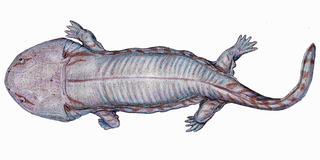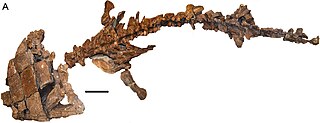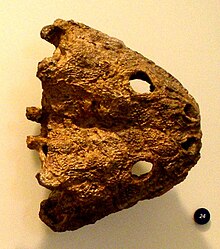
Temnospondyli or temnospondyls is a diverse ancient order of small to giant tetrapods—often considered primitive amphibians—that flourished worldwide during the Carboniferous, Permian and Triassic periods, with fossils being found on every continent. A few species continued into the Jurassic and Early Cretaceous periods, but all had gone extinct by the Late Cretaceous. During about 210 million years of evolutionary history, they adapted to a wide range of habitats, including freshwater, terrestrial, and even coastal marine environments. Their life history is well understood, with fossils known from the larval stage, metamorphosis and maturity. Most temnospondyls were semiaquatic, although some were almost fully terrestrial, returning to the water only to breed. These temnospondyls were some of the first vertebrates fully adapted to life on land. Although temnospondyls are amphibians, many had characteristics such as scales and armour-like bony plates that distinguish them from the modern soft-bodied lissamphibians.

Koolasuchus is an extinct genus of brachyopoid temnospondyl in the family Chigutisauridae. Fossils have been found from Victoria, Australia and date back 125-120 million years ago to Barremian-Aptian stages of the Early Cretaceous. Koolasuchus is the youngest known temnospondyl. It is known from several fragments of the skull and other bones such as vertebrae, ribs, and pectoral elements. The type species Koolasuchus cleelandi was named in 1997. K. cleelandi was adopted as the fossil emblem for the state of Victoria, Australia on 13 January 2022.

The Stereospondyli are a group of extinct temnospondyl amphibians that existed primarily during the Mesozoic period. They are known from all seven continents and were common components of many Triassic ecosystems, likely filling a similar ecological niche to modern crocodilians prior to the diversification of pseudosuchian archosaurs.

The Ischigualasto Formation is a Late Triassic geological formation in the Ischigualasto-Villa Unión Basin of southwestern La Rioja Province and northeastern San Juan Province in northwestern Argentina. The formation dates to the late Carnian and early Norian stages of the Late Triassic, according to radiometric dating of ash beds.

Cherninia is an extinct genus of mastodonsaurid temnospondyl. The type species, Cherninia denwai, is known from the Denwa Formation of India. It is based on a massive skull, ISI A 54, which was originally considered a species of Parotosuchus in 1998 before being given its own genus in 2001.

Chigutisauridae is an extinct family of large temnospondyls. The only genera recognized as belonging to Chigutisauridae at the current time are all from Gondwana. Chigutisaurids first appeared during the Early Triassic in Australia. During the Late Triassic they became widely distributed in Gondwana, with fossils found in South Africa, India and South America. Koolasuchus from the Early Cretaceous of Australia represents the youngest known temnospondyl.

Siderops is an extinct genus of chigutisaurid temnospondyl from Early Jurassic of Australia, containing the species S. kehli.

Brachyopoidea is a superfamily of temnospondyls that lived during the Mesozoic. It contains the families Brachyopidae and Chigutisauridae. The earliest records of brachyopids are from the Lower Triassic in Australia. The latest-surviving member of the superfamily is the chigutisaurid Koolasuchus from the Early Cretaceous of Australia.

Lydekkerinidae is a family of stereospondyl temnospondyls that lived in the Early Triassic period. During this time period, lydekkerinids were widely distributed, with putative remains reported from Russia, Greenland, India, South Africa, Madagascar, Australia, and Antarctica. In contrast to most other stereospondyls, lydekkerinids were relatively small-bodied. The type genus is Lydekkerina, the namesake of the family and the best-known lydekkerinid.

Trematosauridae is a family of large marine temnospondyls with several included genera.

Acroplous is an extinct genus of dvinosaurian Temnospondyli within the family Eobrachyopidae.

Bothriceps is an extinct genus of stereospondyl temnospondyl. It is a member of the infraorder Trematosauria and is the most basal brachyopomorph known. It may be the only brachyopomorph that lies outside the superfamily Brachyopoidea, which includes the families Brachyopidae and Chigutisauridae. It shares several similarities to Keratobrachyops, another basal brachyopomorph, and may be closely related to or even synonymous with it.

Keratobrachyops is an extinct genus of trematosaurian temnospondyl found in the Arcadia Formation of Queensland, Australia. It had been thought to be a basal chigutisaurid but is now thought to be a basal brachyopomorph closely related to the genus Bothriceps, and may even be a synonym of it.

Pseudhesperosuchus is a genus of sphenosuchian, a type of basal crocodylomorph, the clade that comprises the crocodilians and their closest kin. It is known from a partial skeleton and skull found in rocks of the Late Triassic (Norian-age) Los Colorados Formation of the Ischigualasto-Villa Unión Basin in northwestern Argentina.

Brachyopomorpha is a clade of stereospondyl temnospondyls within the infraorder Trematosauria. It was constructed in 2000 to include Bothriceps australis and the superfamily Brachyopoidea. It is phylogenetically defined as a stem-based taxon including Pelorocephalus and all taxa closer to it than to Rhytidosteus. In contrast, Brachyopoidea is defined as a node-based taxon including Brachyops and Pelorocephalus and all descendants of their most recent common ancestor. Because Bothriceps is not thought to be a descendant of that recent common ancestor and would be more basal than it, the genus is placed just outside Brachyopoidea and is considered to be a sister taxon to the clade.
Menadon is an extinct genus of traversodontid cynodonts. The type and only species is Menadon besairiei.
Christian Alfred Sidor is an American vertebrate paleontologist. He is currently a Professor in the Department of Biology, University of Washington in Seattle, as well as Curator of Vertebrate Paleontology and Associate Director for Research and Collections at the Burke Museum of Natural History and Culture. His research focuses on Permian and Triassic tetrapod evolution, especially on therapsids.

Rhytidostea is a clade of stereospondyl temnospondyls. It was erected in 2000 to include several temnospondyl groups distinct from the "higher" group of capitosaurs, including lydekkerinids, brachyopoids, and rhytidosteids. Rhytidosteans first appeared in the Permian period and underwent an evolutionary radiation during the Induan stage of the Early Triassic. Along with capitosaurs, rhytidosteans comprise much of the larger suborder Stereospondyli. Rhytidostea has often been considered the sister group of the clade Capitosauria, but has been placed in various other phylogenetic positions. In many studies, members of Rhytidostea are split, with lydekkerinids having a more basal position among stereospondyls while rhytidosteids and brachyopoids form a group placed among the more derived trematosaurian stereospondyls.

The Terrigal Formation is a geologic formation in the Sydney Basin in eastern Australia. Commonly seen in the Central Coast region, this stratum is up to 330 metres thick. Formed in the early to mid Triassic, it is part of the Narrabeen Group of sedimentary rocks. This formation includes interbedded fine to medium-grained sandstone and siltstone, with minor deposits of claystone. Hawkesbury Sandstone occasionally overlies the Terrigal Formation. Numerous fossils are known from this area, including the temnospondyl amphibian Arenaerpeton supinatus.

Arenaerpeton is an extinct genus of chigutisaurid temnospondyl found in the Terrigal Formation of New South Wales, Australia. The type species is A. supinatus. The genus name is derived from the Latin "Arena", meaning "sand" ; and "erpeton" meaning thing that creeps. The species name "supinatus" means "supine", referring to the fact that the fossil is lying on its back.




















